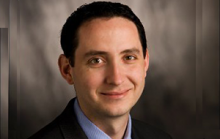For Rotary International's 1.2 million members, relationships provide the true value of the organization. And with 34,000 clubs spread across the globe, it takes powerful technology to help build those relationships among members and also among clubs across distant geographies. In an interview with The Enterprisers Project, CIO Peter Markos, explains how the non-profit makes it work.
The Enterprisers Project (TEP): Tell us about what it's like to lead IT in the nonprofit arena. What are the unique challenges you face vs. other IT leaders?

Markos: I don't think there is a fundamental difference between leading IT at a nonprofit and a for-profit. You simply need to alter your emphasis based on the organization. For example, if I were the CIO at an e-commerce company, I'd be focused on preventing downtime, which can cost the organization millions in sales. At Rotary, success depends on our ability to provide members with networking opportunities and the ability to build relationships across the more than 34,000 Rotary clubs around the world. We focus on and invest in technology that helps to grow these relationships and leads to greater collaboration. This allows us to deliver bigger, more sustainable projects with greater impact.
TEP: Can you give us some examples?
Markos: A year ago we began a multi-year effort of building out our web infrastructure, and relied on an identity management provider as our platform. While it will take additional time to receive the metrics needed to show how this new portal is changing engagement, we have already seen more members interacting through our member hub called MyRotary.
Technology also allows us to give members the tools they need to manage and grow their local clubs, while also providing us better data. For example, we recently rolled out a goal-setting tool that clubs can use to set and track fundraising goals and targets for projects. This has enabled thousands of clubs to do more than ever before, now that all members have visibility and an incentive to meet their objectives. Additionally, we have the added bonus of being able to measure the impact of the individual clubs, and we expect to find that Rotary has a collective impact of over a billion dollars annually around the world. There are very few non-profits with that type of scale and impact. And it's fantastic to be able to see the direct, positive impact that technology has on Rotary's mission.
TEP: An organization like Rotary depends heavily on volunteers. How does technology help keep those volunteers engaged?
Markos: We developed our web strategy to better serve both our members and the general public. We're responsible for helping the general public learn more about Rotary, its mission, and our corporate initiative to eradicate polio worldwide. We must also make sure our members can depend on the website for day-to-day tasks such as running their local clubs, applying for grants or simply connecting with other members around the world.
That can be difficult to do in one website, so we developed separate portals for each audience. There's Rotary.org, which we use to introduce and build relationships with the public and get them involved with Rotary. Once they're engaged with us, they can get access to our member hub MyRotary, where all the information they need is in a single place. Before, they had to visit multiple websites to get the information they needed to accomplish their tasks.
What's also great is that MyRotary has allowed volunteers to share their generous contributions — not just money, but time, talent and expertise. We're able to link and connect Rotarians to information such as presentations, videos, and service projects while also providing a forum for volunteers to share local solutions more easily than before. It's a way to harness the business talents of our professional members, which we can leverage on a global scale to drive greater impact.
TEP: As a nonprofit, do you face budgetary challenges that for-profit companies might not? If so, how do you meet those challenges?
Markos: Remaining within budget is always a challenge — and that's probably true everywhere. The biggest budget challenge we face is that our primary revenue source is driven by membership dues, which have been fairly flat for the last decade as we've hovered steadily around 1.2 million members. However, during the last ten years, contributions to our foundation have continued to increase dramatically, allowing our impact to grow, even as membership has not. Some of those gains are due to technology. By implementing collaboration tools, members are able to do more.
Something that is unique to being a non-profit is the ability to leverage the expertise of your members. For me, utilizing the time and talents of our Rotarians is critical. For example, a lot of our members are CIOs with strong IT backgrounds, or developers and consultants with deep technical expertise. I'm able to leverage them as a sounding board, get their perspectives and find solutions when we might otherwise not have a large enough budget or enough manpower. Volunteers are often wonderful, untapped resources and a unique element that we, unlike for-profit companies, are able to take advantage of as a nonprofit organization. It's unlikely you'd see an organization that makes widgets reach out to its customers and ask them to develop a better widget for the entire company.
TEP: What are your upcoming projects?
Markos: On the corporate level, we're also moving more and more to the cloud because it just makes good business sense. We've recently moved to a SaaS model for email and continue to explore other SaaS solutions where appropriate. At the price point and value, it's a no-brainer to push things to the cloud.
Mobile is a more nuanced scenario for us. We use a mobile-first strategy for content and "light-transactional" functionality, which we implement using responsive design. With Rotarians in 200+ countries around the world, we connect to each differently depending on their cultural and technological backgrounds. In the United States and Europe, members typically have reliable Internet access and connect on computers, but members in Southeast Asia tend to be more mobile-focused and may not even own a tablet or PC. Responsive design helps us meet the diverse needs of our members, but we do try to drive people to devices with bigger screens for certain tasks. For instance, it would be difficult to fill out a 30-page grant application asking for $100k USD on a mobile phone.
TEP: From what I've observed, many Rotary clubs may not have the latest technology. Does this create any challenges, and how do you deal with them?
Markos: It is a real challenge for us. We try to balance the demographics of our members, who tend to be in their mid- to late-50s, and their needs with our efforts to stay current and work with supportable technology. Sometimes we get flak from those using old browsers which tend to be less stable, more vulnerable to security issues and have limited display capabilities. They experience problems accessing our website.
Though it's difficult and time-consuming, we spend a lot of time explaining what we're doing, why migrating to the latest technology adds value to what we do and encouraging them to upgrade. After we work with them, most are really receptive to the change and often exclaim, "I didn't realize what I was missing out on!"
Usability has also become a big focus for us. In the past, we used to think about costs more than value, and as a result, we saw limited adoption of our upgrades and software changes. But now that our emphasis is on providing value to our members, we're focused on delivering usable applications. And the response from our members? A positive one. Not only are they comfortable with the change, they're actually copying our approach. Each club has begun to mimic our delivery of easy-to-use, helpful tools that follow a user-centric approach.
TEP: What advice would you pass along to other IT leaders in nonprofit organizations?
Markos: My primary advice, especially in the nonprofit space, is to think of technology as an enabler of your mission. If you look at the for-profit world, leaders are always trying to find ways to improve efficiency, do more with less and improve the bottom line; it's not any different in the nonprofit world.
Nonprofits need to think about how to leverage technology to improve the way an organization acts on its mission. I'm constantly thinking about what our IT department is delivering, and how the tools we provide members allow them to do more with less time spent on administrative tasks so they can focus on accomplishing great work and giving back in their communities. Technology allows us to lower costs, so more dollars can go toward our mission, which is obviously key. It's about the mission, and IT has never been better positioned to help accomplish it.
ALSO READ
- How a Silicon Valley healthcare CIO balances man and machine
- American Cancer Society CIO entices job applicants with meaningful work and other perks
Peter Markos leads a global team of more than 130 men and women who are responsible for Rotary’s data processing, facilities, printing and distribution, and travel operations as well as all of the organization’s technology needs. He helped establish the organization’s Information Technology Development Center in Pune, India. Markos graduated from the University of Chicago with a degree in economics, and has an MBA from the University of Chicago Booth School of Business. Markos is a Paul Harris Fellow.



